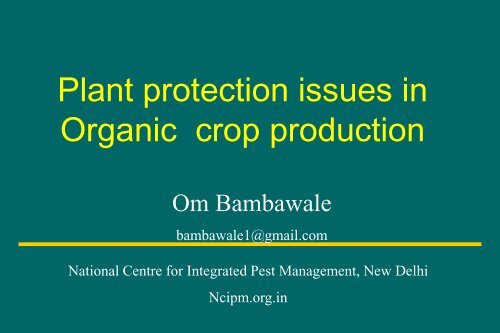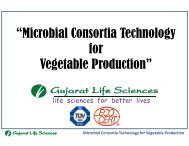Plant protection issues in Organic crop production - Jaibbihar
Plant protection issues in Organic crop production - Jaibbihar
Plant protection issues in Organic crop production - Jaibbihar
You also want an ePaper? Increase the reach of your titles
YUMPU automatically turns print PDFs into web optimized ePapers that Google loves.
<strong>Plant</strong> <strong>protection</strong> <strong>issues</strong> <strong>in</strong><br />
<strong>Organic</strong> <strong>crop</strong> <strong>production</strong><br />
Om Bambawale<br />
bambawale1@gmail.com<br />
National Centre for Integrated Pest Management, New Delhi<br />
Ncipm.org.<strong>in</strong>
Need of The Hour !<br />
Ensure food and nutritional security <strong>in</strong> view of<br />
<strong>in</strong>creas<strong>in</strong>g population with<strong>in</strong> limited resources<br />
Reduce economic losses <strong>in</strong>curred by various pests with<br />
improved plant <strong>protection</strong> practices<br />
80,000 plant diseases, 10,000 <strong>in</strong>sects<br />
30,000 weed species and 3,000 worms<br />
( yield loss 18% Rs 200,000 crores/annum)<br />
Prevent losses caused by various “pests”
INTENSIVE AGRICULTURE<br />
1950 2010<br />
6 Fold <strong>in</strong>crease <strong>in</strong> pests<br />
3 Fold <strong>in</strong>crease <strong>in</strong> losses
Year Outbreaks<br />
2001 All over India Helicoverpa armigera on cotton, pigeonpea and chickpea<br />
2004 Spodoptera litura on soybean <strong>in</strong> Kota region of Rajasthan<br />
2005 Potato late blight <strong>in</strong> the northern belt of Punjab, UP<br />
2006 Gujarat: mealy bug on cotton<br />
2007 Punjab: mealy bug on cotton<br />
2008 BPH and neck blast on rice <strong>in</strong> the northern Indo Gangetic belt<br />
2008 Spodoptera litura on soybean <strong>in</strong> Maharashtra / Potato LB <strong>in</strong> WB<br />
2008-09 Paracoccus marg<strong>in</strong>atus (mealy bug ) on papaya , tapioca, mulberry<br />
Chronic pests<br />
In addition gummosis of citrus, nematode problems on rice<br />
and vegetables, white grubs on sugarcane spread<strong>in</strong>g <strong>in</strong><br />
alarm<strong>in</strong>g proportions
Press<strong>in</strong>g Pest Problems <strong>in</strong> India<br />
Insect Pests<br />
Helicoverpa armigera / Spodoptera / / Rice BPH / stem<br />
borer / White grubs / termites /Fruit fly / Luella<br />
xylostella / Mites /mealy bugs, etc.<br />
Diseases<br />
Sheath blight-neck blast-tungro of rice / maize downy<br />
mildews / bract mosaic <strong>in</strong> banana / Wilts / Virus<br />
diseases / Phytophthora diseases citrus / parawilt <strong>in</strong><br />
cotton/ mango malformation, etc.<br />
Nematodes<br />
Root knots, reniform, burrow<strong>in</strong>g nematodes, root knot<br />
complex with Ceratocystis fimbriata <strong>in</strong> pomegranate /<br />
citrus / root knot on mulbery, etc.<br />
Each pest-type needs to be addressed <strong>in</strong> a different way!
IPM: A susta<strong>in</strong>able approach to<br />
manag<strong>in</strong>g pests by comb<strong>in</strong><strong>in</strong>g<br />
biological, cultural and chemical<br />
tools <strong>in</strong> a way that m<strong>in</strong>imizes<br />
economic, environmental and<br />
health risks.<br />
IPM aims for Susta<strong>in</strong>able Agriculture<br />
Bio-pesticides
Classification of Pest Management<br />
Rout<strong>in</strong>e Rational Integrated Biological<br />
Reductionist<br />
(Pesticide treadmill)<br />
Scale of Pesticide Use<br />
Holistic<br />
(IPM treadmill)<br />
Increas<strong>in</strong>g Stable or Decl<strong>in</strong><strong>in</strong>g<br />
(Benbrook 1996)<br />
The IPM Cont<strong>in</strong>uum<br />
Source : S. Vennila, 2000
Crop varieties with multiple pest<br />
resistant/tolerance<br />
IPM System and its Sub-Systems<br />
VII Chemical<br />
Control<br />
VI Botanical<br />
Pesticides<br />
Judicious use of pesticides<br />
Use of plant products<br />
V Other<br />
Measures<br />
Physical measure like manual removal, radiation,<br />
solar heat treatment, thermotherapy, pheromone<br />
traps etc.<br />
I Host <strong>Plant</strong><br />
Resistance<br />
IPM<br />
IV Biological<br />
Control<br />
Natural enemies, bio-control agents, biopesticides etc.:<br />
application & enhancement<br />
Quarant<strong>in</strong>e, certification of plant<strong>in</strong>g materials etc.<br />
II Regulatory<br />
Measures<br />
III Cultural<br />
Practices<br />
Time of plant<strong>in</strong>g, spac<strong>in</strong>g, <strong>crop</strong> rotation, variety,<br />
mixed <strong>crop</strong>p<strong>in</strong>g, relay <strong>crop</strong>p<strong>in</strong>g, trap <strong>crop</strong>s,<br />
mulch<strong>in</strong>g, fields sanitation, summer plough<strong>in</strong>g,<br />
soil solarization, <strong>in</strong>tegrated nutrient management,<br />
proper irrigation, green manur<strong>in</strong>g, residue<br />
management etc.
IFOAM Basic Standards<br />
International Foundation for <strong>Organic</strong> Agriculture Movement<br />
<strong>Plant</strong> and animal orig<strong>in</strong><br />
Algal preparations<br />
Animal preparations and oils<br />
Chit<strong>in</strong> nematicides (natural orig<strong>in</strong>)<br />
Corn gluten meal (disease & weed control)<br />
Dairy products<br />
Natural acids (e.g. v<strong>in</strong>egar)<br />
Neem (disease & <strong>in</strong>sects)<br />
<strong>Plant</strong> oils<br />
Pyrethrum – the synergist piperonyl butoxide is prohibited.<br />
Quassia<br />
Rotenone<br />
Ryania<br />
Sabadilla<br />
Tobacco tea (pure nicot<strong>in</strong>e is forbidden)
M<strong>in</strong>eral orig<strong>in</strong><br />
Chloride of lime<br />
Clay<br />
Copper salts – max 8kg/ha/year (on a roll<strong>in</strong>g average basis)<br />
Diatomaceous earth<br />
Light m<strong>in</strong>eral oils<br />
Lime sulphur<br />
Potassium and sodium bicarbonate<br />
Potassium permanganate<br />
Silicates<br />
Sulphur<br />
Microorganisms<br />
Fungal preparations<br />
Bacterial preparations<br />
Release of parasites, predators, sterilised <strong>in</strong>sects<br />
Viral preparations
Others<br />
Biodynamic preparations<br />
Calcium hydroxide<br />
Ethyl alcohol<br />
Homeopathic and Ayurvedic preparations<br />
Sea salt and salty water<br />
Soda<br />
Soft soap<br />
Sulphur dioxide<br />
Traps, barriers, repellants<br />
Physical methods (e.g. chromatic, mechanical traps)<br />
Mulches, nets<br />
Pheromones – <strong>in</strong> traps and dispensers only
SUSTAINABLE AGRICULTURE<br />
STARTS WITH A<br />
HEALTHY PLANT
• Healthy <strong>Plant</strong>s<br />
• Pest problems <strong>in</strong>dicate –<br />
Natural Immunity<br />
Resistance to pests<br />
<strong>in</strong>adequate grow<strong>in</strong>g conditions<br />
Predisposition (Theophrastus 300 BC)<br />
Sir Albert Howard<br />
(Father of <strong>Organic</strong> Farm<strong>in</strong>g)
Conservation vis-à-vis pesticide use<br />
High IPM Low<br />
Importance of Natural Enemies<br />
Importance of Insecticides<br />
Low High<br />
Pesticide Selectivity<br />
Temporal separation of natural enemies and pesticides<br />
Spatial separation of natural enemies and pesticides<br />
Improved knowledge of ETL of non target pests and natural enemies
CROP HABITAT DIRVERSITY<br />
ENHANCES NATURAL ENEMIES<br />
SUSTAINABLE PEST MANAGEMENT
Habitat Manipulation<br />
Ecological compensation areas<br />
M<strong>in</strong>imum required ecological compensation areas is 5 to<br />
10% of an agricultural landscape<br />
Tomato + Marigold<br />
legumes with maize<br />
Sp<strong>in</strong>ach / beans / tomato <strong>in</strong> cabbage<br />
Chickpea with barley / mustard / coriander
Provid<strong>in</strong>g Artificial Structures<br />
Spider nos./hill 5.3 (IPM), 1.2 (FP)
Mealy bug <strong>in</strong> cotton - parasitoids<br />
saved Bt technology !<br />
Promuscidea unfasciativentris<br />
Gujarat<br />
Rajasthan<br />
Karnataka<br />
Punjab<br />
Haryana<br />
Madhya Pradesh<br />
Maharashtra<br />
Aenasius bambawalei<br />
Occurrence of Mealy bug and parasitoids <strong>in</strong> Cotton<br />
A<br />
A-Aenasius<br />
P- Promuscidea<br />
A<br />
Delhi<br />
A<br />
P<br />
P<br />
Andhra Pradesh<br />
Tamil Nadu<br />
Gujarat<br />
100% parasitization by Aenasius
AUGMENTATIVE / INOCULATIVE BIOCONTROL<br />
• Pests : Parasitoids, Predators and Pathogens<br />
• <strong>Plant</strong> Pathogens : Antagonists<br />
• Nematodes : Pathogens, VAM<br />
POTENTIAL PARASITOIDS<br />
• Trichogramma spp.<br />
• Apanteles spp.<br />
• Leptomastix dactylopii<br />
• Encarsia gudaloupae<br />
• Aphel<strong>in</strong>us mali<br />
• Goniozus nephantidis<br />
• Epipyrops<br />
PREDATORS<br />
Cocc<strong>in</strong>ellids : Cryptolaemus<br />
Lace w<strong>in</strong>gs : Chrysoperla<br />
Mirids : Cyrtorh<strong>in</strong>us<br />
Predatory mites, Spiders, Birds, Bats,<br />
Frogs
Biological control of <strong>in</strong>sect pests<br />
Available mass <strong>production</strong> techniques for bioagents<br />
26 Egg parasitoids<br />
06 Egg larval<br />
39 Larval / nymphal parasitoids<br />
26 Predators<br />
07 Weed feeders
Insect Viruses<br />
Bacteria<br />
Fungal pathogens<br />
Microsporidia<br />
EPNs<br />
EPN-Symbionts<br />
Microbe alternatives to chemical pesticides:<br />
Insect Pest Management<br />
NPVs, GVs, Non-Occcluded viruses<br />
Bacillus thur<strong>in</strong>giensis, B. sphaericus, B. popilliae<br />
Beauveria bassiana / Metarhizium anisopliae /<br />
Verticillium lecanii / Nomuraea rileyi / Paecilomyces<br />
lilac<strong>in</strong>us / P.far<strong>in</strong>osus / Hirsutella thompsonii<br />
Nosema spp. / Vairimorpha necatrix<br />
Ste<strong>in</strong>ernematids, Heterorhabditids<br />
Photorhabdus / Xenorhabdus spp.
<strong>Plant</strong> disease management<br />
Trichoderma spp. wide spectrum <strong>in</strong>clud<strong>in</strong>g nematodes<br />
Pseudomons fluorescens wide spectrum <strong>in</strong>clud<strong>in</strong>g nematodes<br />
Bacillus subtilis soil borne pathogens<br />
Sporidesmium sclerotivorum sclerotium form<strong>in</strong>g fungi<br />
Coniothyrium m<strong>in</strong>itans<br />
Pythium oligandrum damp<strong>in</strong>g offs<br />
Ampelomyces quisqualis powdery mildews<br />
Talaromyces flavus sclerot<strong>in</strong>ia, Verticillium dahliae<br />
Debaryomyces hansenii / Candida olephila<br />
Saccharomyces cerevisiae / Rhodosporidium Post harvest pathogens<br />
toruloides
MICROBIAL PESTICIDES
Biopesticides registered<br />
1. Trichoderma species<br />
2. Gliocladium species<br />
3. Pseudomonas fluorescens<br />
4. Bacillus species (B. subtillis, B. thur<strong>in</strong>giensis, B. sphaericus)<br />
5. Beauveria bassiana<br />
6. Metarrhizium anisopliae<br />
7. Nomuraea rileyi<br />
8. Verticillium lecanii<br />
9. Hirsutella spp. (<strong>in</strong>cluded <strong>in</strong> the schedule of Insecticide Act)<br />
10. Granulosis viruses (GV)<br />
11. Nuclear polyhedrosis viruses (NPV)<br />
12. Karanj<strong>in</strong> (Pongamia glabra)<br />
13. Cymbopogan species, and<br />
14. Neem based biopesticides
Different type of traps<br />
Kerocene lighted light traps<br />
Sex Pheromone traps<br />
Mat<strong>in</strong>g disrupt<strong>in</strong>g lures<br />
Delta Sticky traps<br />
Pit traps<br />
Water
Critical component of IPM<br />
Monitor<strong>in</strong>g adult population of Yellow Stem borer<br />
• Installation<br />
of<br />
Pheromone<br />
traps (5/ha)<br />
• Walk<br />
through<br />
fields for<br />
physical<br />
monitor<strong>in</strong>g<br />
of <strong>crop</strong><br />
health and<br />
assess<strong>in</strong>g<br />
predator<br />
pest <strong>in</strong>dex.
Light trap safer to Natural enemies<br />
< or = 5<br />
mm<br />
Pod borer moth 2<br />
cm<br />
Most NEs < 5 mm
DEVICE FOR BENEFICIAL INSECTS
Issues <strong>in</strong> Biological Control
Constra<strong>in</strong>ts of Biopesticide Technology<br />
Customer<br />
Level<br />
Market<strong>in</strong>g<br />
Level<br />
Courtesy: Kanbiosys, Pune<br />
Production<br />
Level
Screen<strong>in</strong>g of some isolates of Trichoderma aga<strong>in</strong>st F. ciceri
Specificity <strong>in</strong> Pseudomonas fluorescens aga<strong>in</strong>st S. rolfsii<br />
After three days:<br />
Pseudomonas<br />
(NCIPM)<br />
Control<br />
Specificity <strong>in</strong> Pseudomonas<br />
fluorescens aga<strong>in</strong>st Phytophthora<br />
nicotianae<br />
Pf stra<strong>in</strong>s compatible with<br />
T. harzianum (GB Pant Univ.)<br />
Control<br />
Jaspur isolate Delhi isolate
Species specificity of Beauveria bassiana Verified at<br />
NCIPM<br />
• B. Bassiana CICR, Nagpur stra<strong>in</strong>: Whitefly<br />
• B. bassiana PAU stra<strong>in</strong>s (which are effective aga<strong>in</strong>st<br />
Phomopsis fruit rot of br<strong>in</strong>jal) not <strong>in</strong>fective to H.<br />
armigera<br />
• B. bassiana NCIPM stra<strong>in</strong> highly <strong>in</strong>fective to H.<br />
armigera
Issue of CFU counts of biopesticides<br />
Gap of 10 - 100 Kg /ha between the research<br />
f<strong>in</strong>d<strong>in</strong>gs and the exist<strong>in</strong>g standards of<br />
commercial availability
IPM validation <strong>in</strong> <strong>Organic</strong> Rice<br />
Location : Kaithal (Har)<br />
Area under certified organic rice 896 ha &<br />
200 ha under conversion<br />
Area Under Farmers Participatory trials ( 50 ha)<br />
From : Agrocel Ind., Ltd., Kaithal<br />
Satpal Chahar<br />
Hansmukh Patel<br />
Promod Chouhan
Module – IPM <strong>Organic</strong><br />
• Sanitation<br />
• Elevated fields (fortified FYM [Trichoderma ], BGA-<br />
Biofertilizer, neem cake, bio-tercel etc.,)<br />
• Green manur<strong>in</strong>g with Sesbania /black / greengram<br />
• Application of Rock phosphate<br />
• Seedl<strong>in</strong>g dipp<strong>in</strong>g <strong>in</strong> solution of Pseudomonas spp<br />
• Pheromone traps (YSB) for Monitor<strong>in</strong>g / Trapp<strong>in</strong>g<br />
• Preventive sprays of CaSo4, Trichoderma,<br />
Pseudomonas , neem oil and Herbozymes.<br />
• Detopp<strong>in</strong>g, rope runn<strong>in</strong>g, release of Trichogramma<br />
japonicum, conservation of spiders and other natural<br />
enemies
Challenges<br />
• Scientific validation of traditional agricultural<br />
practices that have <strong>in</strong>creased land productivity<br />
and used resources susta<strong>in</strong>ably, scientific studies<br />
on organic farms that report higher yield than<br />
conventional farms<br />
• Production and supply of organic seeds, organic<br />
manure, organic bio-fertilizers and bio-pesticides<br />
• <strong>Organic</strong> agricultural faculties <strong>in</strong> prom<strong>in</strong>ent<br />
agricultural universities<br />
• Extension services and tra<strong>in</strong><strong>in</strong>g for the farmers<br />
• Government policy <strong>in</strong>itiatives and assistance to<br />
conversion processes<br />
• Development of a local market to supplement the<br />
grow<strong>in</strong>g export market



